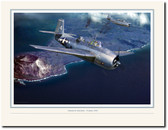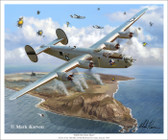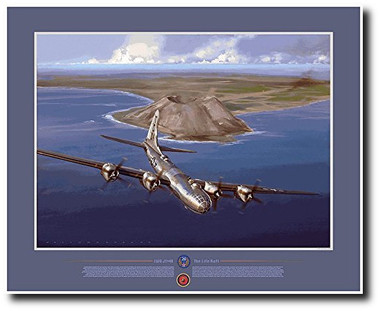 Loading... Please wait...
Loading... Please wait...- Home
- Aviation Art - By Artist
- Iwo Jima The Life Raft
- Home
- Aviation Art - By Artist
- Jack Fellows
- Iwo Jima The Life Raft
Categories
Iwo Jima The Life Raft
Product Description
L/E of 199 Giclee Prints $200.00
10 A/P on Paper or Canvas $285.00
S/N by the Artist
Image Size: 24" x 17"
Paper Size: 30" x 24"
Plane Type: B-29 Superfortress
Located halfway between the main Japanese home island of Honshu and the American airfields in the Northern Marianas, the island of Iwo Jima was considered to be equally useful to both the Americans and the Japanese. The cost of dislodging a well dug-in Japanese defense force would prove to be much more costly to the United States than had been envisioned by US Naval Intelligence, which had over-optimistically predicted the capture of Iwo Jima would take only one week. Operation Detachment as the amphibious landings and subsequent capture of the Japanese airfields was called, took two months rather than one week. The necessity of Operation Detachments enormous cost is still being debated. More than 26,000 US casualties, including 6,800 killed, and the aircraft carrier, USS Bismarck Sea (CVE-95) was sunk. Additionally, Japanese casualties amounted to over 20,000, only in this case they were all killed, with only 206 POWs. Exemplifying the ferocity of the battle, 25% of the 82 Medals of Honor awarded to the USMC during WW II were awarded to participants of the Iwo Jima campaign. A total of 27 Medals of Honor were awarded to the Marines and Navy participants, 22 to Marines and 5 to US Navy Hospital Corpsmen. Regardless of the position taken in the debate over the need for the assault on Iwo Jima, a number of advantages accrued to the victors. The detractors of Operation Detachment have benefitted from hindsight, of course, but the facts remain that for those airmen in trouble above the Pacific on the route from the Marianas to Japan, the value of the Marines and Navys sacrifice is beyond debate. The number of B-29s and crews saved from destruction by enemy fighters over Japan because of the P-51 escorts which sortied from Iwo Jima after its capture is unknown, but nonetheless may be considerable. Longevity of B-29 aircrews shot down over Japan was generally measurable in minutes, even after a safe parachute landing, due to the hostility of the Japanese populace. Of value as well were the lessons learned about what to expect in the future in the way of Japanese resistance to the projected landings on Okinawa, Kyushu and Honshu in the near future. The same was true for calculating the future efficacy of pre-landing naval bombardment against well dug-in defenses, and the folly of future optimism regarding the cost of assaults upon the home islands. Much of the reverence for the heroism of the Marines held today by American civilians can be directly traced back to the huge sacrifices made on Iwo Jima. In the painting we see a 73rd Bomb Wing B-29 rounding Mt. Suribachi at Iwo Jimas southern extremity and take a southerly heading to its base in the Northern Marianas after safely refueling on Iwo Jima. PLANE JUNKIE - Iwo Jima The Life Raft by Jack Fellows (B-29 Superfortress)








